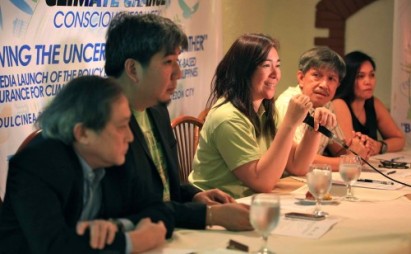Near 20 Million Peso revenue reached for One Festival Manila
We wish to thank those that support us and will continue to show they are standing by us. To those that will support us in the near future, we extend our gratitude to you in advance. Our tally for the support we have generated for One Festival Manila as of the end of October 2014 is now Php19,153,087.71 equivalent to the amount in US dollars of $425,908.11.
We urge our philanthropists, charitable individuals and groups, we invite groups like OXFAM, MISEREOR, CARITAS, CARE, CHU TZI FOUNDATION, among others, to join the effort despite that they are already involved very deeply with recovery and rehabilitation efforts in disaster affected areas in the Philippines.

Moving Concert Schedule to December 12, 2015
We postponed the main event behind One Festival Manila to 2016, however, as a dry run for the 2016 event, we moved the first One Festival Manila event from December 4, 2014 to December 12, 2015. The second date of the rock festival is scheduled for December 17, 2016.
The One Festival Manila Philippines, concert date moved from December 13, 2014 to December 12, 2015.
The First International Geo Hazard Mapping Summit Manila Philippines, conference date is declared moved from December 4, 2014 to December 8, 2016.
The Second One Festival Manila Philippines, concert date is at the culmination of the International Geo Hazard Mapping Summit – December 17, 2016.
| December 2015 | ||||||
| 1st One Festival | ||||||
| Sun | Mon | Tue | Wed | Thu | Fri | Sat |
| 1 | 2 | 3 | 4 | 5 | ||
| 6 | 7 | 8 | 9 | 10 | 11 | 12 |
| 13 | 14 | 15 | 16 | 17 | 18 | 19 |
| 20 | 21 | 22 | 23 | 24 | 25 | 26 |
| 27 | 28 | 29 | 30 | 31 | ||
| December 2016 | ||||||
| 1st International Geohazard Mapping and 2nd One Festival | ||||||
| Sun | Mon | Tue | Wed | Thu | Fri | Sat |
| 1 | 2 | 3 | ||||
| 4 | 5 | 6 | 7 | 8 | 9 | 10 |
| 11 | 12 | 13 | 14 | 15 | 16 | 17 |
| 18 | 19 | 20 | 21 | 22 | 23 | 24 |
| 25 | 26 | 27 | 28 | 29 | 30 | 31 |
Moving the Geo Hazard Mapping conference
Following our series of communiques to the United Nations Secretary General beginning on the aftermath of tropical cyclone Ketsana (Ondoy) and before and after the tragic November 2013 disaster caused by Haiyan (Yolanda), the UNOCHA wrote to the organizers of the First International Geo Hazard Mapping Summit stating that the United Nations only supports government efforts.
Abiding by this policy, the organizers coordinated and held several meetings with various agencies of the public sector: the Department of National Defense, Bureau of Customs, Metro Manila Development Authority, among many others.
This, notwithstanding the general record of performance of the incumbent regime in the Yolanda tragedy where it dared everyone not to make a move to give help to the victims or else.
Or the regime’s record of lack of crisis management savvy or is absent of any concern and compassion in other disasters and crises in the country where people instead of being saved helplessly died.
And most of all, the shocking propensity of the regime to amass with wild abandon trillions of pesos of cash stolen from the National Treasury that even the entire leadership of the Catholic clergy have joined the ranks of those seeking regime change, policy reform and ending the unconscionable piracy upon the Philippine public coffers.
Meanwhile, in between their thievery of taxpayer money, they encourage dumping of Canadian and God knows what other toxic garbage into the Philippines, allow syndicates to perpetuate crimes against the environment, pretend to show interest at climate risks management and engage in nationwide grandstanding to make the regime appear as if it is clean, honest and full of virtues and integrity. Seriously, guys, a great big uprising, upheaval is now in order here. We cannot always afford to be victims forever.
When all the legacy that will be left by the Corazon Aquino regime and this incumbent presidency is dumb goofing and wanton thievery of money belonging to the people. Including among those they stole are disaster relief funds and items. You can just imagine the callousness of these would-be national leaders.
Organizers’ representatives initiated talks with the Office of the Mayor of Manila and several other key officials that will be in one position or another, be able to ensure the success of the undertaking.
Thus far, since 2009 to the present, between the previous administration and the incumbent one, only Ms. Elaine Bautista (now Mrs. Horne), and former Department of Environment and Natural Resources head Jose L. Atienza responded to the invitation of the organizers to take an active part in firming up all the needed requirements for the geohazard mapping conference.
On its own instead, from the non-mandated to the quasi-mandated units of the public sector as well as by the Mines and Geosciences Bureau, a large number of haphazard mapping activities were initiated, declared completed and some haphazard similar projects are still ongoing as of this time.
Even the University of the Philippines in partnership with the National Commission Against Poverty, of all agencies (!) have announced that they have finished creating a geohazard map.
So now, there are a good number of small-budgeted geohazard mapping efforts and those behind them are pleased to announce they have completed their task. However, no one else in the previous and current regimes wanted to join the effort to undertake comprehensive geohazard mapping.
The international geohazard community of practice produced several interested scientists, however in relation to the entire universe of geohazard experts the ones that showed support for the project are extremely in the minority.
The community is a great disappointment since many of its members cannot decide on their own. And they are therefore enmeshed in the proxy wars their sponsors are fighting. We consider this to be stupid but what can our brother and sister scientists do? They won’t survive without their masters.
Still this further inspires us to move forward with even greater intensity. As we await for more resources and more moral support to filter in we will definitely get closer to our foreseen objectives and targets.
We laud all these individuals and groups in pitsi pitsi (piecemeal) mapping efforts and we encourage them to join our campaign to promote and encourage coordination with the international geohazard mapping community, or what is called the geohazards community of practice.
We wish to invite them to share the view that any single geohazard is ultimately connected to the global system of hazards. Therefore, any mapping that can be done on a limited area can be enhanced with linking and correlating to the global geohazards system – GGS.
On the other hand, the United Nations, during and following the period of our correspondence with them from 2009 to 2013, suddenly announced that they have a similar activity to HMES that they called the World Disaster Risk Reduction Conference that they scheduled 4 months after the HMES summit schedule of December 4, 2014.
UN announced that it will hold the WDRR summit in Sendai, Japan. At that point in 2013-early 2014, we determined that with the cold shoulder of the UN and members of the geohazard community with the exception of its members from Afghanistan, Pakistan, Nepal, Saudi Arabia, among a few other countries, we have to reschedule our project date.
We warmly wish UN and Japan will have a successful 3rd world risk reduction conference as we struggle to generate greater interest and concern for global geo risks mapping.
Despite the great upheaval in the georisk mapping community and elsewhere generated by our advocacy and similar advocacies by like minded and kindred individuals and groups, we will proceed to catalyze, instigate more change, more policy regime and paradigm shifts.
Already the Philippine weather agency, the PAGASA has acted positively in relation to our and allied persons’ and groups’ campaign to enhance the Philippines’ and other countries’ forecasting and public alert system for typhoon, cyclone, flood and rainfall – particularly in the kind of disaster that events like these will bring.
To all those that want to help us in the project please contact us through Email: saferecover@msn.com, Tel.: +6325058107, Mobile: +639212261611; +639174760651.






































































